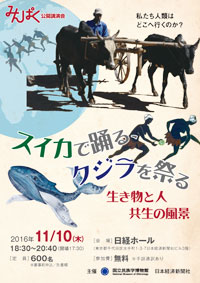Historical Ecology of Biocultural Diversity: Use and Conservation of Endangered Animals, Plants, and Habitats
Theme Category:Environment 1. Environmental problems and biodiversity
Project Leader:IKEYA Kazunobu・KISHIGAMI Nobuhiro
Project Period:July 2016-March 2019
Purpose and content of the project
In considering the relation between contemporary civilization and environment, the conservation of rare species and the maintenance of biodiversity are said to be central challenges in global environmental problems. This project is intended to consider the relation between contemporary civilization and environment through grasping the use and extinction of endangered animals and plants, changes in conservation, and the problems raised there, centering on a historical ecological approach to the relationship between humans and environment from prehistory to present day. Specifically, the research grasps the history of human impact on the environment characteristics around the world, including cold districts (far north), islands and oceans (Oceania), deserts (Africa), forests (Amazonia, tropical Asia, and Japan), and inland waters (China). Consequently, it is also an attempt to consider the reciprocal relations among animals and plants and human society at the global, continental, and regional levels. Refer to the following literature for recent research trends in historical ecology: William Balee 2006 The Research Program of historical Ecology. Annual Review of Anthropology. Vol. 35: 75-98. In the literature, no citation is made from examples in Japan and research results produced by Japanese researchers. The project aims to disseminate studies in environmental anthropology conducted at Minpaku to date nationally and internationally, and to position them among international studies.
Expected results
With regard to the conservation of rare species and the maintenance of biodiversity, studies have accumulated in various disciplines, including law, politics, economics, geography, and sociology, placing ecology at the center. However, the perspective of historical ecology is an area of study that has become increasingly popular in recent environmental anthropology. In the project, we shall hold an international symposium by inviting front-line researchers in the theme this time and shall publish the results as a collection of English papers. Therefore, it is expected that not only will studies in this area contribute to research in environmental anthropology in English-speaking countries, but will also be basic literature forming a foundation for discussing problems of biodiversity in a broad and interdisciplinary manner. Particularly, such studies will help internationally disseminate studies conducted at Minpaku by considering studies of ecological history (including ecological history of livelihood, such as slash-and-burn agriculture and livestock farming in the world, and research on ecological history of civilization) that have been conducted mainly by Minpaku researchers and which have been numerously published in Japanese.
Minpaku Public Lecture
November 10 (Thursday), 2016, 18:30 ? 20:40
Minpaku Public Lecture:
Where is humankind headed?
Dancing with watermelons and worshiping whales in festivals: landscapes of people and other creatures living together
Venue Nikkei Hall & Conference Room
Program
Moderator: NOBAYASHI Atsushi (Professor of National Museum of Ethnology)
| 17:30 | Open |
|---|---|
| 18:30 | Start by SAKAMOTO Hironobu (Executive Officer of Nikkei Inc., Managing Editor of Osaka Head office) |
| 18:35 | Opening address by SUDO Kenichi (Director-general of the National Museum of Ethnology) |
| 18:40 | Briefing on the lecture meeting by IKEYA Kazunobu |
| 18:45 | Lecture 1 by ENDO Hideki |
| 19:10 | Lecture 2 by KISHIGAMI Nobuhiro |
| 19:35 | Lecture 3 by IKEYA Kazunobu |
| 19:55 | Break |
| 20:10 | Panel discussion by ENDO, KISHIGAMI, and IKEYA |
| 20:40 | End |
International Symposium
March 26, 2017
Human Relationships with Animals and Plants: Perspectives of Historical Ecology
![[img]](http://www.minpaku.ac.jp/sites/default/files/research/activity/project/msrp/img/environment01.jpg)





